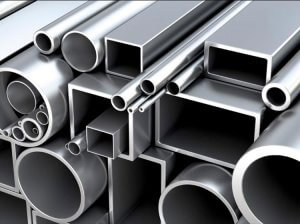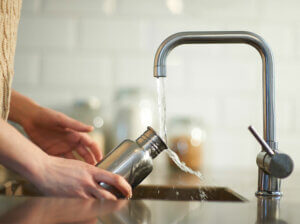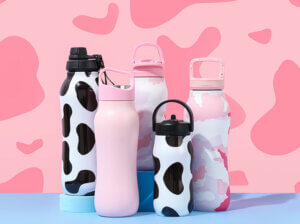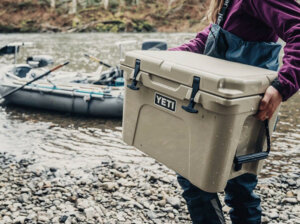When two different grades of stainless steel are placed side by side, under most circumstances the naked eye can never distinguish which is which. However, at the molecular level, there are massive differences.
The question of 304 versus 316 stainless steel is often one of the most important questions to answer when it comes to choosing a stainless steel material for their insulated water bottle business. Both common grades of stainless steel and one of the most common materials used to make insulated bottles share many characteristics, but also have some unique advantages that set them apart. So, what is 304 stainless steel, and what is 316 stainless steel, and what is the difference between 304 and 316 stainless steel?
In this article, we will compare 304 versus 316 stainless steel head-to-head. Facilitating your choice when conducting your insulated water bottle business.
A brief introduction to 316 and 304 stainless steel
These two types of stainless steel are found in a broad range of industries. As the most common grade of stainless steel, 304 is considered the standard “18/8” stainless steel. 304 stainless steel is widely used for its durability and ease of forming into various forms such as stainless steel sheets, plates, bars, and tubes.
Chemical Compositions of 304 Stainless Steel
| Element | % Present |
| Carbon(C) | 0.07 |
| Chromium(Cr) | 17.50 – 19.50 |
| Manganese(Mn) | 2.00 |
| Silicon(Si) | 1.00 |
| Phosphorous(P) | 0.045 |
| Sulfur(S) | 0.015b) |
| Nickel(Ni) | 8.00 – 10.50 |
| Nitrogen(N) | 0.10 |
| Iron(Fe) | Balance |
Chemical Compositions of 316 Stainless Steel
| Element | % Present |
| Carbon (C) | 0.07 |
| Chromium (Cr) | 16.50 – 18.50 |
| Manganese (Mn) | 2.00 |
| Silicon (Si) | 1.00 |
| Phosphorous (P) | 0.045 |
| Sulfur (S) | 0.0151) |
| Nickel (Ni) | 10.00 – 13.00 |
| Nitrogen (N) | 0.10 |
| Iron (Fe) | Balance |
| Molybdenum (Mo) | 2.00 – 2.50 |
What is the difference between 304 and 316 stainless steel?
1. 316 has a higher nickel and molybdenum content while 304 contains slightly more chromium
304 stainless steel contains slightly more chromium than 316 and lower nickel content. It is more resistant to corrosion than 316 due to the higher chromium content, but 316 is more resistant overall due to its higher molybdenum content (molybdenum makes up about 0.2% of 304 and 0.4% of 316). For this reason, 316 is often recommended for use in marine environments or other situations where exposure to saltwater or other corrosive chemicals is likely to occur.
2. Difference in heat resistance between 304 SS and 316 SS
Heat resistance is an important consideration when comparing different grades of stainless steel. 304 has a higher melt range than 316 by about 50 to 100 degrees Fahrenheit. Although 304 has a higher melt range than 316, they have good oxidation resistance at 925°C (1697°F) in both intermittent and continuous use up to 870°C (1500°F).
- 304 SS: Handles high temperatures well, but continuous use at 425-860 °C (797-1580 °F) may result in corrosion.
- 316 SS: Performs best at temperatures above 843 °C (1550 °F) and below 454 °C (850 °F)
3. Price Difference Of 304 SS and 316 SS
What makes 316 more expensive than 304 stainless steel? The increase in nickel content and the addition of molybdenum in 316 make it more expensive than 304. On average, 316 stainless steel is 40% more expensive than 304 stainless steel.
Moreover, the price difference between 304 and 316 stainless steel will depend on what kind of application you’re using it for, but technically speaking there isn’t much difference in price between them either way: both types are much less expensive than other types of high-quality metal such as titanium or aluminum alloys (which can cost upwards of $10 per pound).
4. 316 vs. 304 stainless steel: which is better?
When comparing 304 stainless steel and 316, they both have advantages and disadvantages when deciding which one to use for different applications. For example, 316 stainless steel is more resistant to salt and other corrosives than 304. Therefore, if you are making a product that will be exposed to chemicals or marine environments on a regular basis, 316 is the better choice.
On the other hand, if you make products that do not require high corrosion resistance, 304 is a practical and economical choice. For many applications, 304 and 316 are virtually interchangeable.
5. Difference in durability and hardness between 304 SS and 316 SS
Both stainless steels are very hard and durable. In terms of tensile strength, they are virtually identical. 316 stainless steel has a higher yield strength, but the difference is relatively small. When hardened by cold working, both 304 and 316 stainless steel can achieve higher hardness and strength levels.
6. Difference in Corrosion resistance between 304 SS and 316 SS
This is where 316 stainless steel shines the brightest. 316 stainless steel is more resistant to corrosion than 304 stainless steel, especially chlorides. This makes it a common choice for marine equipment and other applications where materials are exposed to extremely high concentrations of chlorides or other oxidizing agents. However, 304 stainless steel still has excellent corrosion resistance, so this is usually only a factor in marine environments and other highly corrosive locations.
Conclusion:
304 stainless steel is the most common type of stainless steel on the market today. In fact, 304 stainless steel accounts for more than half of the world’s stainless steel supply. This is because 304 stainless steel offers an excellent balance of price and performance. Its strong corrosion resistance and extreme durability combine to make it the standard choice for many industries. 304 stainless steel is a versatile material for most applications, and choosing 304 steel will almost always result in significant cost savings. On the other hand, if you make products that really need high corrosion resistance, or if you are looking for a higher quality stainless steel bottle, then 316 stainless steel would be a better choice for you.
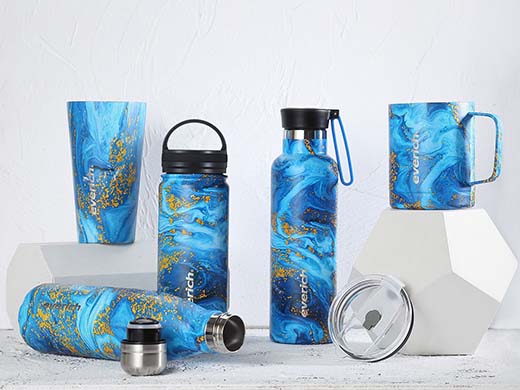
Everich‘s stainless steel bottles are made of 304 and 316 stainless steel to meet your needs for different projects. Both stainless steels are food-grade and have strong corrosion resistance, acid and alkali resistance, and toughness. While the vast majority of our clients may choose the cost-effective 304 material, we can also produce 316 stainless steel bottles if you need a higher-quality stainless steel bottle.
We have stainless steel bottles of various designs, colors, sizes, and shapes to meet your needs for various occasions. We also accept custom logos, sizes, shapes, colors, and cover types. Contact us for an order as soon as possible! And enjoy our insulated water bottle here.

